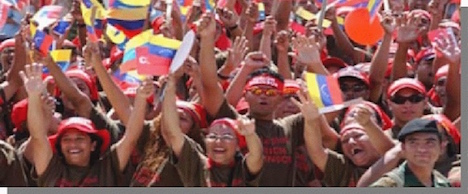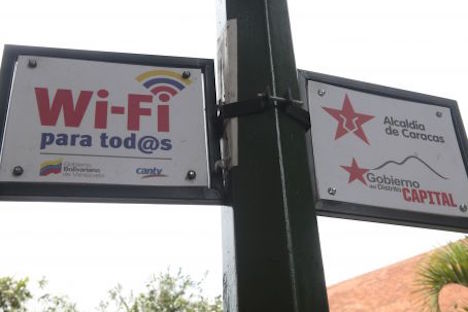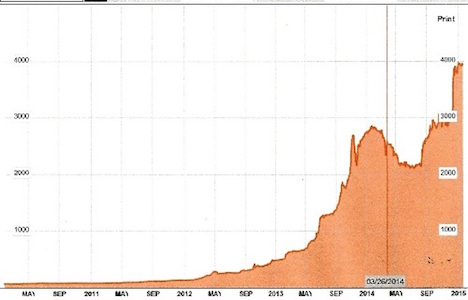|
Looking back over the whole of this century the
month of January has invariably begun with negative forecasts for the
Venezuelan economy by capitalist “experts” known for their blind adherence to
the financial model that almost brought down the world economy in 2008.
January
2015 has proven to be no exception to this regular event.
 |
| Venezuela in the top 5 of happy countries |
|
Basing its
forecasts on the sharp fall in the international crude oil price from about US $95/barrel
to around US $40/barrel at present, the IMF is forecasting doom and gloom for
the Venezuelan economy in 2015. According to the neoliberal economist Alejendro
Werner, who is responsible for IMF evaluations in Latin America, the Venezuelan
economy is forecast to shrink by 7% in 2015 after shrinking by 4% in 2014.
The 4%
figure is interesting as it is totally inaccurate. In his speech to the nation,
President Maduro stated that the economy has shrunk by 2.8% in 2014. So from
where Werner conjured up the 4% figure is a mystery. Perhaps from the hocus
pocus of IMF methodology?
There are
always coincidences, internationally speaking, when it comes to
Venezuela-bashing both at home and abroad. For example, this month there are
cries that President Maduro has to “change the economic model” to save
Venezuela and turn around the situation that has been caused by hoarding, price
speculation and an attack on the currency. The model that is espoused in the
corporate media is of course, free market capitalism.
When
Venezuela was run along such lines in the ‘happy 1990s’, inflation averaged
around 52% per year for 8 years or so, peaking at over 103% in 1995. Wages were
frozen for three years and the whole country was plunged into a recessionary
vortex.
Do we
really want such an economic model here again? Just look at the state Europe is
in right now. The macro figures may look better than those of Venezuela overall
BUT: unemployment has skyrocketed to a record 22 million; workers have had
their wages reduced by 30% in Spain and Portugal; austerity in the best
tradition of IMF medicine is being applied, making people’s lives miserable;
pensions have been reduced or eliminated; and millions have had their homes
foreclosed or are ‘under water’ with their mortgages. Moreover, even though
there are now more jobs appearing in places, reduced wages make life untenable
for workers and their families with no tangible rights or recourse.
Looking at Venezuela’s performance since 1999
The economic
model launched by the late Comandante Chávez in 1999 is another matter, the
results of which are deliberately ignored, both nationally and internationally,
in the private and corporate media. Some selected achievements are:
- Poverty has fallen from over
60% in 1999 to 19% in 2014
- Absolute poverty has fallen in
the same period from 23% to 5%.
- GDP has grown from US $90
billion in 1198 to US $374 billion in 2013, according to the CIA Fact
Book.
- Venezuela paid off its debt to
the IMF in early December 2001 and its external debt in dollars is
approximately 35% of GDP. (Compare this to Europe which is about 80%
overall, and the USA whose debt burden is about 105% of GDP).
- In 1998 there were 600,000 university
students – now there are 2.7 million
- Chavez opened 35 new
universities in just over 10 years.
- In 1998 there were 300,000
pensioners receiving appalling benefits; but now there are almost 3
million receiving the national minimum wage and its corresponding
increases.
- 95% of children now attend
school compared to under 86% in 1998
- There are 600 rehabilitation
clinics and 550 diagnostic clinics all built during the Chavez period to
give free health care to all Venezuelans.
- There are 2,300 free cyber
cafes and all major towns and cities have or will have free Wi-Fi access.
 |
| Free Wi-Fi |
|
- More than 673,000 dwellings
have been completed for the people with a further 400,000 planned for this
year. Resources have been approved and are available for this major
project.
- Venezuela has two orbiting
satellites and a third is being constructed in Venezuela by local
technicians trained in China.
- Wages have outstripped
inflation since 1999 with regular increases
being approved to offset the
inflationary effects of the economic war.
- Venezuela was awarded a prize
by the UN Food and Agriculture Organization (FAO) in 2013 for “doing more
to defeat hunger than any other country this century”.
- Venezuela has achieved all the
Millennium Goals set out in 2000. These include giving access to drinking
water, education, health care and reducing hunger and poverty.
- Infant mortality has fallen
from 25 per 1000 in 1990 to 13 in 2012 according to UNICEF.
 |
| Venezuela youth celebrating University Student Day during a grand march in Caracas in November, 2014. |
Based on
these revolutionary achievements – does Venezuela need to change its economic
model and listen to the talking heads of the IMF and self-interested
entrepreneurs? Draw your own conclusions.
This
century, the private banking sector has made more money than ever before and
the Caracas Stock Market has risen from 8991 on December 31st 2002 to
nearly 4,000,000 this month. Yes, that’s 4 million. In fact, due to the rise,
the stock exchange authorities lopped off three zeroes from the index figure to
make it more manageable. This measures the success of the private sector in Venezuela and is still the most dynamic stock market in the world due to the demand-driven
economy here, which benefits the companies quoted in the index below.
 |
| Caracas Stock Exchange Five Year performance |
The
economic results have yielded a better quality of life for Venezuelans overall
despite the 15 year campaign in the international media trying to discredit all
the achievements of the Bolivarian Revolution.
Human Development Index (HDI)
Here is a
table of the components of the United Nation’s Human Development Index (HDI) from 1980 to 2012 for Venezuela, clearly
illustrating the advances made for a population that is now reaching 30 million
(at the end of the last century it was around 23 million according to the 1999
census).
Looking at
the following table, do readers really think that the Venezuelan government
should change to a free market capitalist model just to satisfy the unbridled
greed of corporations and local businessmen longing for cheap dollars with
which to feather their nests and bank accounts in the north?
Note that
the HDI figure in the right hand column is based on a maximum of 1.00, which
indicates the highest level of human development. The figure of 0.748 for 2012
places Venezuela in the high human development category. The highest HDI figure
in the region is 0.758 for Panama, followed closely by Cuba.
Bolivarian
Republic of Venezuela’s HDI trends based on consistent time series data, new
component indicators and new methodology
 |
| Children in La Guaira |
|
GINI Index
Another key
international index that illustrates the success of Venezuela’s socialist
economic model promoted by the Bolivarian revolution and its policies is the
GINI Index that measures the Distribution of Family Wealth in a country. The
CIA World Fact Book lists all countries’ (except Cuba) GINI Index performance.
The lower the figure, the more equal a society is. We can see examples of
societies with social justice in mind from the figures below as well as
neoliberal inequality taking more for the already well-off on other examples.
|
Country |
GINI Index (after) |
GINI Index (before) |
Arturo Comments |
|
Argentina |
45.8 (2009) |
------- |
The land
owners still have sway here |
|
Bolivia |
47.0
(2011) |
57.9 (1999) |
Evo’s
social revolution |
|
Brazil |
51.9 (2012) |
55.3 (2001) |
More
noise than results |
|
Chile |
52.1 (2009) |
57.1 (2000) |
Still
capitalist with growing inequality |
|
China |
47.3 (2013) |
47.4 (2012) |
Slowly
improving |
|
Colombia |
55.9 (2010) |
55.6 (1996) |
Neoliberalism
taking its toll |
|
Costa Rica |
50.3 (2009) |
45.9 (1997) |
Same as
Colombia, increasing inequality |
|
Haiti |
59.2 (2001) |
-------- |
The first
slave revolution still being castigated |
|
Mexico |
48.3 (2008) |
53.1 (1998) |
Better
than expected with the US right next door |
|
Nicaragua |
40.5 (2010) |
50.6 (1997) |
Sandinista
Revolution |
|
Norway |
25.0 (2010) |
25.8 (1995) |
Social
Democracy in action but still capitalist |
|
USA |
45.0 (2007) |
40.8 (1997) |
More for
the one percent |
|
Venezuela |
39.0 (2011) |
49.5 (1998) |
10.5 point improvement thanks Comandante
Chávez and Cuba |
Based on
these results, does Venezuela need to change its economic model from the
socialist path to one of free market capitalism? I guess the answer is no, as
the lot of most Venezuelans has improved significantly since 1999.
The
improvement is because oil revenues have been sown for the first time in the
interests of the population as a whole. Since 1999, 60.3% of all oil revenues
have been invested in health, education, and social programs – whereas in the
previous 40 years of capitalist policies only 37% were destined to the masses.
In
addition, billions of bolivares (the national currency), are now collected from
all types of tax revenues by the Venezuelan Inland Revenue Service (SENIAT). While
these bolivares finance many projects and 69.7% of the Social Missions – funding
for the cornerstone of the social revolution is generated from local tax
collection, according to Ricardo Sanguino, president of the Financial
Commission of the National Assembly.
Changing the Economic Model
The
economic model in Venezuela does need changing, but not in a retrograde sense
back towards free market capitalism. This is despite induced inflation,
contraband and shortages that must gradually be defeated by combined governmental
and institutional actions, backed by organized people.
First, the private
sector has to be brought to heel – especially distributors and wholesalers – and must be made to serve the interests of the country by applying the laws and the
Constitution.
After the
experience of the oil industry sabotage of December 2002–February 2003, when
the private sector tried to starve the population and the revolution into
submission, it was clear that the distribution system should be changed even
then so as to safeguard food supplies from being diverted, smuggled, or
hoarded.
Now, since
mid 2013, the private distribution sector has made life difficult for all
Venezuelans when trying to find basic goods. These companies must be obliged to
act responsibly and not favor destabilization for political reasons. If they
continue on their current path, confiscation of businesses and all assets, plus
jail time for the perpetrators, is the only answer.
This is the
first change in the economic model that must be implemented as soon as
possible.
The second
change must be the installation of a more endogenous productive model so as to
substitute many imports of food and medicines. Food imports had been very high
for years – around 65%, but declined to around 35% (not including wheat which
does not grow in these climes) during the revolution.
Conclusion
Despite
economic problems caused by the economic war fostered by US covert action in
Venezuela to create the illusion in the media that everything is a disaster,
the facts prove that the economic model introduced by Chávez has worked,
benefitting great swathes of the population. Even the capitalist private sector
has benefitted thanks to higher wages and government investment in the
population and the economy as a whole.
This
progressive model must continue despite cries that it is unsustainable due to
the fall of the oil price. Financing has been secured until at least the end of
2016 to ensure that the economy remains relatively stable and as Venezuela is a
sovereign, independent state, the government can generate money in local
currency – exactly what the US Federal Reserve does and as the European Central
Bank is proposing to do with the €1.1 trillion it has grasped out of thin air
to boost the European economy. Hence, Venezuela is using the same banking
mechanisms as the developed countries so as to advance the wellbeing of its
still growing young and dynamic population.
© Copyright 2015 by AxisofLogic.com
This material is available for republication as long as reprints include verbatim copy of the article in its entirety, respecting its integrity. Reprints must cite the author and Axis of Logic as the original source including a "live link" to the article. Thank you!
|

